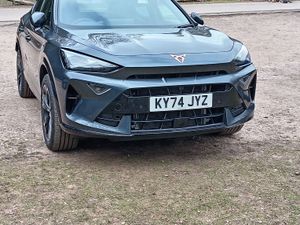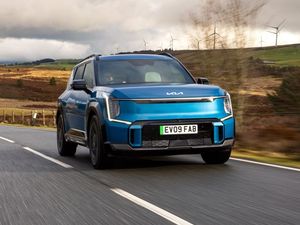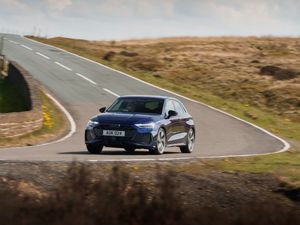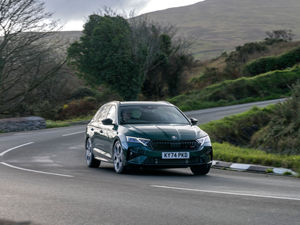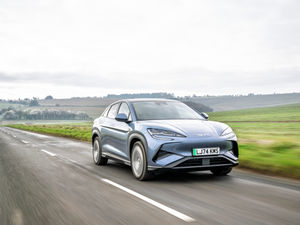First drive: The Volkswagen Golf remains as classy and premium as ever
Ted Welford heads to Portugal to test the all-new eighth-generation VW Golf
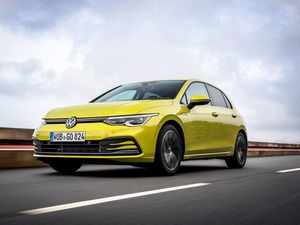
What is it?
Just like mince pies at Christmas and hot cross buns at Easter, the Volkswagen Golf seems to be eternal. It’s remained unfazed by the whole ‘dieselgate’ debacle and has cleverly evolved to become electrified and connected – ensuring VW doesn’t shun its changing customers.

It’s by far Volkswagen’s most popular car and is arguably one of the most important new cars on sale – given it’s rarely seen outside of the top five best-selling cars list. After more than 45 years on sale, Volkswagen has managed to produce a remarkable 35 million examples, and come February 2020 you’ll be able to buy this all-new eighth-generation example. But can this new version continue to lead the path like the last example did?
What’s new?
In typical Golf style, this latest model looks like it could just be a facelift, but it’s underneath and inside where Volkswagen has been waving its magic wand.
Starting with the interior, Volkswagen has completely digitalised the cabin, getting rid of the majority of physical buttons and fitting the car with a 10-inch touchscreen and digital cockpit as standard, the latter being unique to this class – for the time being at least. Further tech introduced includes Car2X – essentially where the Golf can ‘communicate’ with other cars and infrastructure.

And in terms of electrification, Volkswagen is introducing mild-hybrid technology to the Golf – at first with a TSI petrol engine when paired with an automatic transmission.
What’s under the bonnet?
Powering our test car is the 128bhp variant of the turbocharged 1.5-litre, which comes mated to a six-speed manual transmission – expected to be the best-selling configuration.
It’s a good mix for the Golf – offering excellent refinement as you can barely hear it at low revs, while cylinder deactivation tech is just one of the touches that go into making the engine more efficient than before, although VW can’t give us the figures just yet.
While performance isn’t this engine’s strong point, it’s a good all-rounder, feeling plentiful at motorway speeds while also having a bit of buzz for the more twisty roads. Admittedly, it can feel sluggish at times when overtaking, although the 148bhp variant of the same engine provides the remedy for this.
What’s it like to drive?
The story of the Volkswagen Golf for years has been that it’s a comfortable and refined option, and that undoubtedly remains the same with this new model.

Even at motorway speeds the Golf is impressively refined – only a bit of wind noise from the door mirrors making its way into the cabin – giving a comfortable and supple ride that isn’t even hampered by our test car’s 18-inch alloy wheels. For now, we can only imagine how silky smooth it feels on the entry-level 16s. It’s certainly no surprise that the Golf has become such a fleet favourite – there are few better cars at this price point that would be more comfortable to trundle up and down the motorway in.
But while being a great cruiser, it’s not a byword for driving enjoyment. Sure, body roll is well controlled and the steering is smooth and linear, but it’s all very safe and predictable. That’ll be ideal for the vast majority of buyers, but if you want a dash of sparkle behind the wheel, the Ford Focus or Mazda 3 are better choices.
How does it look?
In true VW fashion, the Golf’s design has evolved rather than revolved – though why would you change such a popular and winning formula?
Viewed side-on, you’d be hard-pressed to notice the difference, aside from the all-new line-up of alloy wheels – particularly as it retains near-matching dimensions to the outgoing car.

But it’s the front where you’ll notice most of the changes with its new LED headlights, while a full-length front apron gives the Golf a more aggressive look than before.
Jumping to the rear, you’ll notice Volkswagen’s prominent new logo (it’s slimmer than before, if you couldn’t tell) along with more prominent ‘GOLF’ letter≠≠ing beneath the badge – a classy touch in our eyes. The full suite of LED lights are also prominent at the rear.
So, while this might not be a revolutionary design, it’s a classy update and one that will undoubtedly appeal to the Golf’s loyal buyers.
What’s it like inside?
The new interior is headed up by a huge 10-inch touchscreen that seems to control, well, everything. All physical buttons seem to have been eradicated to create this entirely digitalised interior – helped by the new ‘Hello Volkswagen’ voice control service and touch buttons dotted throughout, even for the sunroof.

While it certainly looks the part – transforming the Golf for the ’20s – we can’t help but feel this needless button-removing has gone too far. Merely changing the temperature means you have to use this slightly awkward slider positioned below the touchscreen when a traditional rotary knob would do a much better job with less hassle.
Aside from that, it’s all business as usual inside, with the Golf offering a generous amount of rear space for its size. While the 380-litre boot isn’t class-leading, it’s more than generous enough for a family hatchback. Visibility is also faultless.
What’s the spec like?
If you’re familiar with VW’s trim level structure, you’ll know all about Volkswagen’s trademark S, SE and SE L grades that have lasted the test of time.
But for a change of scenery, Volkswagen is now adopting new nomenclatures – meaning Golf, Life, Style and R-Line are the options from launch, the last grade being the only aspect of continuity.

Standard kit is excellent and includes LED headlights and keyless start plus a 10-inch infotainment screen that offers a host of connected services as well as the digital cockpit. Plenty of safety kit is also offered – namely lane-keep assist and automatic emergency braking.
Volkswagen hasn’t yet announced prices for the new Golf, although given this jump in out-of-the-box equipment, we’d expect a noticeable rise on top of the outgoing Golf’s £21,120 starting price.
Verdict
Volkswagen already had a near-class-leading model with the outgoing Golf, and it didn’t need to do a great deal to this new eighth-generation model to bring it right to the forefront of the competitive family hatchback class.
With this 1.5-litre petrol configuration, it leaves you wanting for very little, and the Golf would be a terrific choice if you spend lots of time cruising on the motorway. Although the fiddly new touchscreen might be a gripe at first, we’re in no doubt that it would be quickly adjusted to once you’re living with it on a daily basis.
With efficiency figures and pricing yet to be revealed, it’s a bit soon to say if the new Golf is the new ‘car to beat’ in this class, although the pathway seems to have been laid.

